Written by Joel T. Lewis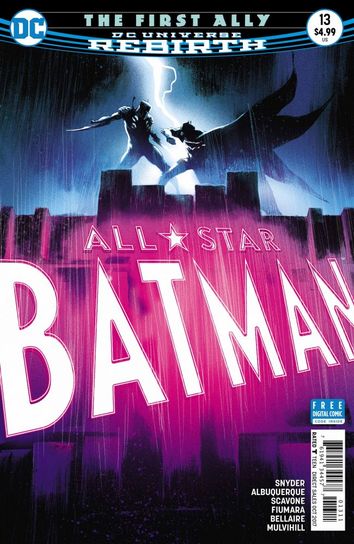 After narrowly escaping a jumbled bloody death under the tons of concrete and glass sent tumbling to the ground by the Black and Whites, Batman and Alfred begin a short-lived pursuit of Hush and company to the Silent Key Retreat owned by Hush’s parents in his youth. As our heroes draw nearer to their would-be murderers, Snyder sends us back in time once again to uncover another layer of Alfred’s history with the Nemesis Program. We catch up with a turbaned Alfred nearing the end of his Nemesis training in Morocco. Through panels of spectacular quality, we see Alfred complete a mission to transport a deadly disease to his mentor Briar using his own body as a host. The dexterity and commitment to the mission that Alfred demonstrates in these flashbacks mirror the qualities that he shapes and encourages in Batman later on. In a quiet moment of rare vulnerability following the mission Briar reveals to Alfred that his own son took on the mantle of the Black Knight and was killed when he jumped in front of a bullet meant for Briar. Briar laments the weakness and vulnerability of his former pupils because of their preoccupation with the loved ones they've left behind. Briar’s unsettling revelation leads Alfred to snoop around in his mentor's files and he discovers that in order to make him a more perfect Black Knight, Briar has plotted to murder his father. In the present, Snyder shows us that as Batman catches up with the Black and White’s helicopter which he discovers was ambushed and that the people aboard are seriously injured. Unwittingly springing their well-placed trap, Batman is quickly dispatched by Briar and the Black Knight. Briar taunts Alfred over Batman’s comm system, telling him that he plans to use the Genesis Engine to reprogram Bruce into the perfect Black Knight that Alfred failed to be. Filled with righteous rage, Alfred returns to the Pirate Base from a few issues previous and recruits the now-leaderless compatriots of the Pirate Thatch to assist him in rescuing his son. Issue 13 closes with an image of Alfred strapped like a pirate version of the Punisher, ready for war saying, ‘Yo $%^& Ho. Get your guns, mates. You're coming with me.’ 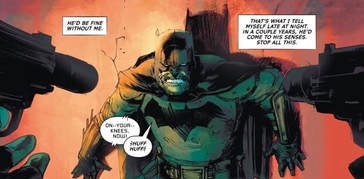 Apart from particularly gorgeous art and color work courtesy of Rafael Albuquerque and Cris Wands and Punisher Pirate Alfred, issue 13 of All-Star Batman presents perhaps the best and most pointed visual representation of the effect that Batman has on those closest to him. As Batman and Alfred careen towards the earth surrounded by tumbling sheets of glass and concrete in the opening sequence, their desperate struggle mirrors that faced by those tangled up in the Batman Crusade. Alfred, seeing the impending demise of his precious son, struggles to free Batman from the duty of saving his life. Were he not bound by duty to save his surrogate father, Batman’s descent would become simple and easy. However, Batman clasps all the tighter for Alfred’s struggling, overcoming even the ripping of his cape (their only hope for slowly down and landing safely). Batman wills his success into existence, defying the physical limitations of his equipment, and finding a way to win, a way to continue his impossible quest. In those moments of struggle, Alfred stands for all who come into contact with Batman. Grayson, Todd, Drake, Barbara and Jim Gordon, have all resisted and inevitably fallen victim to the twisted web of Batman's mission. The significance of this sequence of pages is that we see the person most near the center of the Bat-Family fight and kick and scream against the will of the Batman. All to no avail. The mission is accomplished and Batman comes out on top regardless of how Alfred feels about it. With the strength of the fatherly themes Snyder has developed in this arc, it's important to remember that Alfred, compassionate father that he strives to be, is powerless against the whims of the cruel Batman crusade, more so than any sidekick, collaborator, or even Arch-Nemesis. Alfred truly is Batman’s First Ally but in many ways he is Batman’s first victim as well. The next issue of All-Star Batman will be the last, and though I'm sad to see this series end, I'm very excited to see how this final storyline wraps up. Until next time, Geek On!
0 Comments
Written by Joel T. Lewis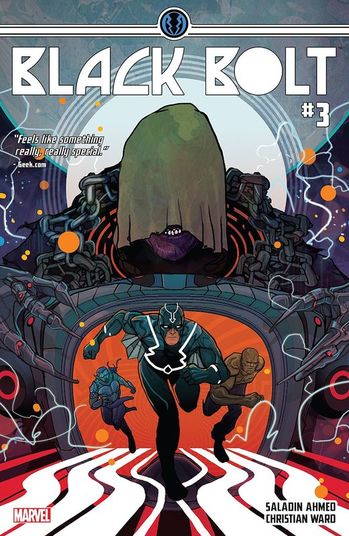 Saladin Ahmed and Christian Ward’s Black Bolt No. 3 has all the components of the perfect prison break story. A well-balanced and diverse crew whose personalities clash enough to create sparks but not fire, a plan with room for heroism and improv as opportunities to rescue fellow inmates arise and new obstacles appear, and finally it has to be visually interesting to watch unfold. As Crusher Creel, Black Bolt, and Raava face off against the grotesque guard Spyder in order to reclaim their unique abilities there is time for quips, camaraderie, and Ward’s spectacular use of color and character design. Dispatching the guard quickly, Black Bolt and company secure the device that will allow them to rescue Metal Master and the many-eyed child Blinky, and hunt down the cruel Jailer. As the rag tag group reunites and their powers flood back into their bodies, Ward treats us to a two-page spread showcasing the renewed strength of each character. Black Bolt’s panel, which bleeds over and behind those around it, is particularly well executed as the Inhuman monarch swells with power. The would-be escapees then encounter a massive being in the next cell over whose initial strike of defense is mistaken for aggression. Blinky, using her telepathic ability, discovers that the massive being is only a child of his species and reacted out fear and not malice. Following this misunderstanding the group discussion over whether or not to enlist the monstrous child in the hunt for the jailer is quickly silenced by a particularly vocal and passionate Blinky, despite the insistence of Raava. Moving on in pursuit of the Jailer the team discovers that at the center of the massive, bizarre prison is a massive combustion engine. An engine fueled by the suffering of the prison’s inmates. The Jailer appears and after a wild technicolor battle which concludes with the newly re-powered Black Bolt whispering the word ‘Die,’ it is revealed that the jailer is far more terrible than the apparition they were led to believe was the Jailer. The true being is massive and in segments, hooked into the infrastructure of the prison, and a terribly powerful telepath. As the issue ends, Black Bolt is ripped from the fabric of reality, head first, and his unspoken scream dies in a throat fading into white light. 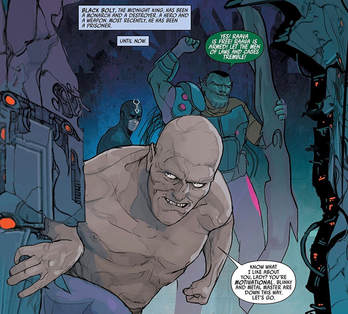 This issue, apart from serving as a well-crafted prison-break storyline, intensifies the level of cruelty and injustice on which the space prison operates. The cruelty and misunderstanding that the colossal child’s incarceration represents makes us and Black Bolt question the fate he had decided his brother Maximus the Mad deserved. The child certainly did not deserve to be tortured and then fed off of in the way the Jailer sustained himself. Can Black Bolt believe that Maximus, villain though he is, had earned this level of cruelty? We also get a passionate vocal development in Blink’s character as she steps in to stop Black Bolt from harming the colossal child. More than just a child figure herself, an object to be imperiled and rescued, with her powers reinstated, Blinky proves to be wise, compelling, and compassionate. Ironically enough, it is the power of Blinky’s voice, her shout of ‘Listen,’ which compels Black Bolt to stop his attack. It will be interesting to see if her character is lost to the winds after the Black Bolt series or brought into to some more cosmic storylines. I would love to see her interact with Moon Girl and Devil Dinosaur perhaps, or some mini-series where she and the colossal child make their way home. It’s always exciting to see new and interesting female children characters have such a dramatic impact on more established heroes. Ahmed and Ward are a powerhouse on this book. Some of the pages are mad spirals of technicolor mayhem and some are tight, intimate settings for serious discussion, and the visual and text components of the issues are extremely well married. I’m am very excited to review issue no. 4! Until next time, Geek On! Written by Joel T. Lewis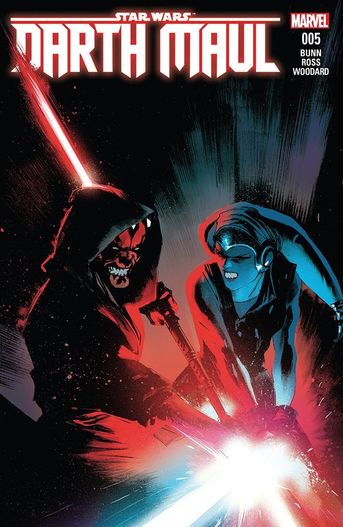 To characterize my first experience reading Cullen Bunn’s work as a roller coaster ride would not be inaccurate, or even an exaggeration. I've shifted from glee to frustration to about everything in between at least a dozen times over throughout the Darth Maul mini-series and finally we have arrived at the conclusion. I can only applaud Bunn and company for closing out the series with a well-crafted conclusion worthy of the Star Wars canon. There's not much to tell by way of plot in this issue as the majority of pages are taken up by the final Padawan/Sith showdown that the series promised from the very first installment. Blades clash as Maul ruminates over the joy of finally realizing his life's purpose: the extermination of Jedi Knights. Both colorist Nolan Woodard and artist Luke Ross shine as lightsaber blades flicker and play against the shadowy backdrop of the deserted Moon. As Maul and Eldra cross blades and match wits, Maul’s arrogance and over-confidence rear their ugly heads a few times, challenging his assumptions about his opponent and sparking his imagination with fantasies of turning Eldra to the dark side. This final battle is so effective first, as the culmination of the tension Bunn built up over the course of the first 4 issues of the series, but also as a delicate dance of character and sensibilities as Maul develops respect and near admiration for his opponent. There is an almost sweet moment following the final blow as Maul assures the fast-fading Padawan that though she had told him she was merely a pupil he considered her to be every inch a Jedi, and a worthy adversary. I must praise Luke Ross here again as the nuance that he brings to Darth Maul’s facial expression at the moment he defeats Eldra is spectacular and poignant. There is recognition and surprise that Ross conveys through Maul’s face that his internal monologue only makes plain in the final panels of the issue, several pages later. Maul is surprised at finally penetrating Eldra’s defenses but you can also see the loss he experiences as that final saber thrust snuffs out the prey he was so desperate to engage. Maul realizes in this moment that the purest joy of his life, the euphoria he will chase for the rest of his life, fighting and killing the Jedi, is so fleeting that he will never be satisfied. This self-awareness, while utterly devastating, does little to slake the Sith’s thirst for carnage as Xev Xrexus falls under his blade shortly after the Padawan’s death. Maul then returns to Coruscant and discovers that not only was his Master aware of his Padawan hunt, he also approved of the act of defiance. The series concludes with a profile of a creature molded for vengeance who has learned that his blood-lust will never be sated, and waits anxiously for the next opportunity to hunt the Jedi. One of the most remarkable feats of Bunn’s mini-series was the way he took a seemingly limiting period of Darth Maul’s history and told a pretty significant, character-driven story wherein both the audience and Darth Maul discover the futility and sadness that characterize his most fundamental desires. The relationship Bunn establishes between the Sith Lord and vengeance so effectively mirrors that between addict and addiction that we begin to reframe our understanding of Darth Maul. This is no small feat and I'm very impressed that Bunn was able to round out a character so inherently mysterious in only five issues. There were moments during this series when I was tempted to give up and I'm very pleased that my perseverance paid off. This creative team is superb and I'm excited to see more great comics from them in the future. Until next time, Geek On! Written by Joel T. Lewis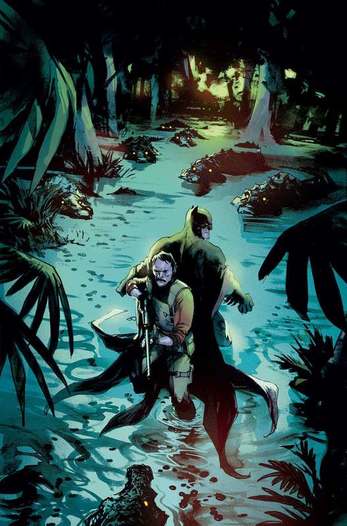 Trapped under the waves in a compromised submarine, Batman commandeers control of the craft with the following announcement to the crew and guests, ‘Listen up, people! As of this moment, you have a new captain...Captain Batman.’ You could fault Scott Snyder for riding the Pirate element of this final arc of All-Star Batman so hard if it wasn’t so damn fun. Batman narrowly escapes a watery grave with the assistance of a pair of torpedoes trained on the screaming voice of Alfred patrolling above the ocean’s surface and a trio of mermaids (sure, they’re actually underwater performers hired by the Pirate Tiger Shark but hey, they’re Mermaids all the same). Snyder then time-jumps back to a revived young Alfred who has been taken to a dungeon underneath the infamous Traitor’s Gate at the Tower of London and we finally learn about Alfred’s association with the twin-bladed knight from the previous issues. Alfred joins what was called the Nemesis Program, a tradition of errant knights who did the will of the British Crown as an enemy of the state in order to protect King and Country from the messiness of direct engagement via military force in the past or MI6 later in history. Agent Codename Briar became Alfred’s mentor with an eerie similarity to what Alfred in turn became for Bruce Wayne. Alfred became England’s Black Knight, and trained to serve the Crown by becoming its most cunning traitor. Now we as readers discover this truth several pages before it is revealed to a recovering Bruce Wayne whose dogged pursuit of the mysterious knight inspires an uncharacteristically violent objection from Alfred. Sitting up from his recovery bed next to a still incoherent Hush, Bruce senses his surrogate Father’s tone and inquires about Alfred’s history with the knight and as the Butler is explaining the folly of pursuing Briar and his new knight, machine gun fire from a helicopter interrupts their discussion. Turns out that the now-conscious Hush and the rapidly descending members of the Black and Whites (Black Mask, Penguin, and Great White Shark) had plotted together to manipulate Batman into obtaining the Genesis Engine from the very start and the issue concludes with Alfred bleeding from machine gun wounds and the building that Batman had made their base of operations crumbling around them as two wrecking balls smash into the walls. With every arc of All-Star Batman Snyder has chosen specific touchstone elements to explore with the characters of Batman. With ‘My Own Worst Enemy’ he showed a new layer of intimacy and immediacy to Batman’s stake in Harvey Dent’s fall from grace, with ‘Ends of the Earth’ he wove one-shot issues with distinct and unique villains together into a complex plot orchestrated by Ra’s al Ghul. But what I’ve loved about this final arc has been the care with which Snyder has dealt with the connection between Alfred and Bruce. Alfred has narrated every issue in this arc and the care and fatherly affection that is evident from how he talks about Bruce and his crusade is very satisfying as a Batman fan. Especially as we have become aware of the tension caused by Alfred’s absentee father and the specific cause of that void being the Wayne family it is truly touching to see the flawed, but loving father figure that Alfred has become. Too often Alfred is set dressing or comic relief. In this comic for the first time I really feel that I have a deeper understanding of the man behind the man behind Batman. The Batman paradigm doesn’t function without Alfred, and with this story Snyder has shown us just how lost Bruce would be without his Butler, and how lost Alfred would be without Bruce. Until next time, Geek On! Written by Joel T. Lewis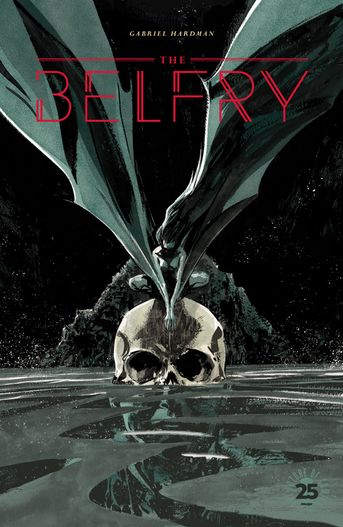 As a consumer of media there has been one genre in particular I have been woefully late to the party on. That genre is Horror. This is largely due to the fact that I scare easily. To give you a sense of the level of scaredy cat that I have been, back in the 90’s the popular PBS series Wishbone did an episode on Mary Shelley’s Frankenstein. Yes, Wishbone. That lovable Jack Russell Terrier whose love of books and adventure fueled a generation’s taste for literature. After seeing that episode I had nightmares and avoided both horror and Wishbone from that day forward. Fast-forward to a few years ago and I slowly began to rediscover a genre loved by many. On my journey of rediscovery I’ve found that comics are one of the most accessible delivery methods of horror. Man and Swamp Thing were my introduction to comic horror and I found that reading about figures so fascinating and grotesque that I could keep safely wedged between the pages of a comic book helped me feed my hunger for horror without losing sleep. The designation of Horror Comic is what led me to Gabriel Hardman’s The Belfry. That and the requisite kick-ass cover art that I’m eternally susceptible to. The Belfry was a title I wasn’t able to pick up on the day of release and I was unlucky enough to make my way to the comic shop too late to obtain a copy in the weeks that followed. This is a common occurrence, especially with One-Shot titles, as comic book vendors will either sell out of them, or file them in long-box limbo never to be found by the diligent seeker, so I had resigned myself to ordering the issue online sometime down the road. Imagine my happy surprise to discover Gabriel himself minding his own booth at Denver Comic Con! Honestly, I must have passed his booth half a dozen times walking the floor but I’m so glad that on this pass the stack of Belfry copies caught my eye! Hardman was working on some commissioned sketches during a lull in foot traffic, and when I trotted up to his booth he seemed a bit surprised by the giddy 6 foot 4 fan nerding hard over the much sought after one-shot. While describing my unsuccessful search for the issue to Hardman his surprise at my appearance relaxed into the inward smile of creator happy to discover his work had been so desperately sought after by someone other than himself. My signed copy of the Belfry is one of my most prized possessions and luckily the contents of the issue are just as cool as the silver-inked signature that now adorns the cover. I wouldn’t want to spoil this twisted, wonderfully horrific one-shot for you but suffice it to say that Hardman’s visual storytelling is outstanding and the variation he plays on bat-themed horror is wildly entertaining and terrifying. Hardman’s gritty, shadowed art-style is perfect for horror and his nightmarish tale leaps off the page as tooth meets flesh and wing stretches toward sky. As horror is not his genre of choice, Hardman used The Belfry to experiment with a new genre with outstanding results and luckily for us he is currently working on another horror one-shot for Image Comics. Hardman was very kind to me and has been one of the most responsive comic creators on twitter so if you do end up checking out his work (and you totally should) be sure to give him a follow. Until next time, Geek On! Written by Joel T. Lewis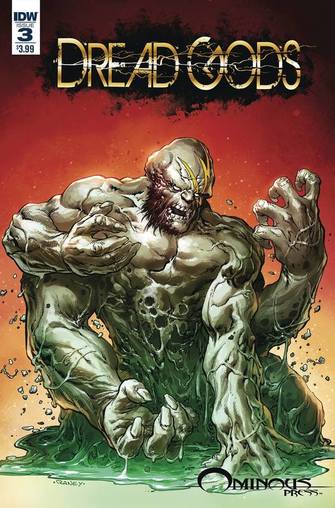 The world thought it had seen the last of the Creator-Owned Ominous Press when it failed to garner support from a large comic book audience in the early 90’s. But at this year’s Denver Comic Con, Chief Creative Officer and originator Bart Sears and Editor-in-Chief Ron Marz unveiled their new partnership with IDW for the relaunch of the Ominous Press brand. Attending the ill-timed Sunday morning grand relaunch panel, I was lucky enough to receive complimentary copies of issues 1-4 of Ominous’ Legendary reprint series which features original content from 1994 and 6 pages per issue of new framing content and Ominous’ World Premier preview issue. The 4-part Legendary series with its newly printed connective tissue narrative bears the telltale signs of an ambitious if unfocused vision for a comic book universe in the early 90’s. While Legendary is by no means as visually indecipherable as Image’s 1993 title Trencher (which I’ve written about previously) it’s 90’s art content bears a similarly challenging color and visual scheme which renders the text difficult to read and the action difficult to follow. However, the artwork by Andy Smith, Ray Kryssing, T.J. Tobolski, and Mark Pennington (in issue 3: Mael’s Rage), is rich and fascinating despite being visually challenging. The characters are rich and colorful, powerful and mysterious, and though sometimes it is difficult to assess what is going on from panel to panel, I can’t stop looking at them. Story-wise you encounter a similar sense of confusion reading the Legendary title as the vague gravity of the vintage material is intersected by the added framing material, and rather than firmly establishing the scope of the Ominous narrative the transitions between these stories further muddy the waters. That being said, I am encouraged by what the content of the 4th issue of the Legendary title and the World Premier Preview issue indicate about the future of the Ominous Press storyline. Previously unreleased, Legendary 4: Death of Pheros marks the most polished and modern of the mini-series as the artwork is tasked exclusively to Andy Smith and creator Bart Sears. This issue’s framing material is better integrated and doesn’t seem to be battling the aesthetic of the 90’s source material as much simply because there is less of it to reconcile. The visuals in this issue are no less breathtaking for only having two contributing artists as the characters leap off the page, bold and imposing as ever. Also, the Preview issue was invaluable for understanding the grand ambitious narrative that Sears and Co. were attempting back in ‘94. The Preview clearly lays out the Ominous narrative of seven worlds, embodying separate popular sci-fi and fantasy genre tropes, in various stages of siege by order of a tyrannical god, the Dread Lord Omin, a prophecy involving world defenders called the Chosen with appointed allies called Champions, and the one true Chosen Auoro who is destined to defeat Omin and secure the fate of the seven worlds. Explained as it is by the Preview issue, the Ominous narrative is far-reaching and intricate, but nowhere near as confusing and vague as it is made out to be by the Legendary series. The Preview issue also showcases the 3 flagship titles that Ominous will be relaunching with: Giantkillers, Prometheus, and Demi-God. Giantkillers, in my opinion the most interesting of the three, follows Arkon the Champion assigned to Auoro, the mythical Chosen One destined to defeat Omin. Arkon is cursed to be flung randomly across the 7 worlds and is separated from his charge for 7 years. Defeated and without purpose, Arkon re-embarks on his search for Auoro and his quest to defend her across the 7 worlds. As the narrative most central to the larger narrative of Ominous Press, Giantkillers is most likely the title which will determine the success or failure of the relaunch, and if the brief preview featuring excellent artwork and a tight internal monologue narrative is any indication, Ominous is on the right track. Written and illustrated by Bart Sears, Giantkillers is a title I’ll be watching out for in the coming months. 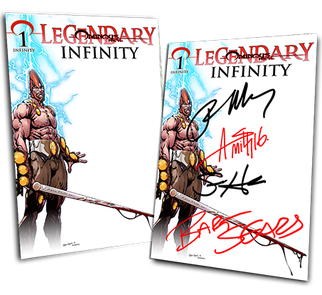 What do you get when you mix Greek mythology, the Matrix, and Gladiator? Chances are it’d look a lot like Prometheus. Written by Ron Marz and illustrated by Tom Raney, Prometheus is centered on a group of god-like heroes whose adventures and acts of might inspire a whole world. Unfortunately, this is all a facade aimed at subjugating and enslaving the population. This series follows the journey of the Prometheans after discovering their high fantasy lives were fabrications and their quest to free the people of their world from the grips of slavery. This playful variation on the Greek Gods promises to be a tangled weave of adventure and discovery and it will be fascinating to see how this world’s narrative ties into the larger conflict with Omin. Finally, the Preview issue introduced the Demi-God series. Meet the self-styled Hercules, a hero equal parts Deadpool, Booster Gold, and Wonder Man whose ego and preoccupation with monetizing his newfound powers outweigh (at least initially) his desire to protect and defend the citizens of his world. Arrogant, obsessed with hawking merchandise, and touting his ‘Hero Brand’ Demi-God could very well be an interesting commentary on the selfie generation’s preoccupation with branding and celebrity punctuated with some epic fist fights with classic Herculean foes. The teaser we get in the preview features a great reimagining of Cerberus the three headed dog brought to life by artist Andy Smith. Demi-God is also written by Ron Marz and will be hitting stands soon. Ominous Press seems to have learned from the mistakes of the past and are poised to make a promising 2nd attempt at popularity. I was lucky enough to speak to both Ron Marz and Bart Sears in person as the crowd thinned out towards the end of their panel and it was really cool to see the excitement and passion that these two veteran comic creators exhibited talking about a press all their own. Be sure to look out for Ominous Press titles coming soon distributed by IDC! I can tell you I will be eagerly awaiting Giantkiller no. 1! Written by Joel T. Lewis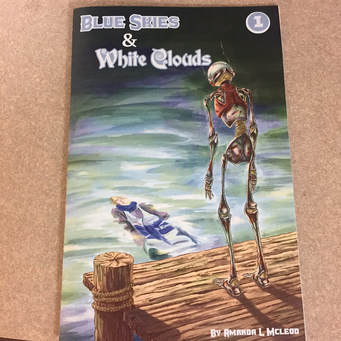 Amanda McLeod was the very first comic book artist that I ever got to talk to face to face. Walking the floor of Artist Valley at Denver Comic Con in 2015 I kept circling back to a particular booth with a sketch that I couldn’t get out of my head. It was an eerie, reed-like, and skeletal robot creature like nothing I’d ever seen before. Watching my bank account trend all too quickly toward zero throughout the weekend, I finally drummed up the courage to step up to her booth and ask about the character. I was nervous. New to the 3-day experience at Denver Comic Con and having never talked directly to a comic book artist before, I wasn’t sure whether I would get a sales pitch or a moody creative who would brush off my inquiry. I got neither. McLeod was an excited and earnest creator who was so happy to have somebody to talk to about her work! This experience, this instant link through excitement and creativity was the perfect snapshot of what Comic Con is about. Nerds excited to meet Nerds who create Nerd things and Nerds who’re excited to share the Nerd things they’ve made. I got my very first commissioned sketch and my first self-published comic book ever from Amanda. The following year I scoured the booths in Artist’s Alley searching for issue 2 of Blue Skies and White Clouds but to my sorrow it hadn’t been produced yet. Having given up hope for issue 2 in 2017, imagine my surprise as I caught sight of the same fascinating character that stuck in my mind two years ago. I stopped dead, whirled towards the booth, and got to catch up with Amanda. Having taken a year off to complete her Master’s Thesis, Amanda was back with issue 2 hot off the presses and was as earnest and excited by my fan-boying as she was the first time. I was far less tentative as I spoke to her this year, as my surprise and excitement bubbled up by the sight of the 2nd issue. Amanda is an exceptional artist and an ambitious writer whose first two issues set up a narrative filled with mystery, technology, and magic. We follow the misadventures of Amy, Mariano, and the Azure Thief (the skeletal robot) in a tale of curiosity, identity, and secrecy. Amy and Mariano bring to life the junkyard robot they’ve been fiddling with and adventure ensues as the Thief tries to reconcile memories with reality while avoiding discovery and capture. I don’t want to give away anymore of the plot than that because both issues of Blue Skies and White Clouds are available online and I’d love you to be able to discover for yourself the talent of an artist who made Denver Comic Con special for me. The first two issues of Blue Skies and White Clouds are available online at http://blueskiesandwhiteclouds.smackjeeves.com/ Written by Zeke Perez Jr.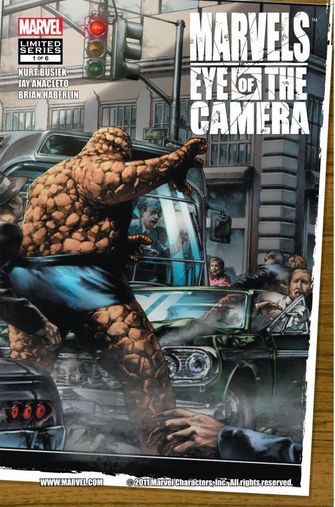 What would it be like to live in a world with superheroes? When we watch superhero movies or read comic books, we’re transported into such a world. But what if you woke up tomorrow and that world came to you? What if you looked out your window only to see a man in a blue spandex suit stretch his limbs or a flaming human figure flying through the sky? What if superhumans, mutants, monsters, and other creatures were all a part of everyday life, battling it out in your hometown? Plenty of recent movies and shows from both Marvel and DC focus in on the impact that heroes would have on the average people around them. In Spider-Man: Homecoming, the central villain is directly motivated by the destruction that heroes were responsible for in the Battle of New York. Students at the Midtown School of Science and Technology learn about the Sokovia Accords in history class and gossip about the Avengers. In Luke Cage, a street side bootlegger sells videos of ‘The Incident’. In Batman v. Superman: Dawn of Justice, the latter is brought to court to account for the destruction of Metropolis brought about by his battle with General Zod. He becomes a controversial figure as people are torn between supporting him and heroes like him for the good they do or condemning them for their unchecked powers and the havoc they wreak. The theme of the conflicted citizen is a very valid one. Superhero movies or comics have often overlooked the impact that superheroes have on the cities they fight to save. The plot implications of buildings being leveled and lives ruined are ignored for the sake of big special effects budgets. But in Captain America: Civil War and the movies mentioned earlier, citizens living amongst superheroes has become a key plot point. That makes for a perfect time to read or re-read Marvel’s Marvels: Eye of the Camera. Marvels: Eye of the Camera is a sequel to the original Marvels, a four-issue comic series written by Kurt Busiek and released in 1994. Marvels examined the Marvel Universe through the eyes of everyman photographer Phil Sheldon. Marvels: Eye of the Camera followed up 15 years later with a six-issue series reprising the characters and the format. Sheldon struggles with his legacy and worries that the public views heroes as ‘sideshow freaks’ because of how his work was framed. He rejects his publisher’s idea of releasing a book about super villains, hoping to avoid increasing fear in the community. 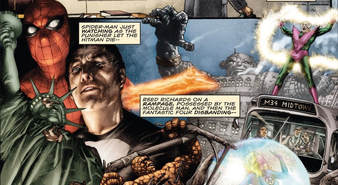 Citizens are coming to terms with their feelings about mutants, taking positive and negative stances on the matter, often revealed through ‘man on the street’ style interviews. The language used in Eye of the Camera fosters the sense of mystery that comes with being an onlooker in a superheroic world. Rumors of ‘a monster in the southwest’ send photographers ‘to New Mexico to try to get pictures of this hulk out there’. Other characters are revealed in a similar fashion. In the Eye of the Camera universe, reports on heroes or mutants are everyday news. They even become so frequent that viewers lose interest and the reports eventually turn into mundane celebrity gossip (along the lines of, ‘who is Invisible Girl dating now?!’). Heroes are almost a nationwide spectacle, with The Thing appearing at Muscle Beach to promote a Fantastic Four movie or with the Avengers hosting open tryouts at Yankee Stadium. Sheldon is conflicted about this and the role of the media, asking ‘Did we corrupt them, drag them down to our level?’ The series should excite any Marvel fan, as it boasts an unbelievably long roster of Marvel heroes either making an appearance or being referenced. Another truly outstanding aspect of the series is that it almost acts as a historical fiction book. Every picture or storyline of a superhero in the comics is taken from its original comic appearance, complete with a reference table in the back of the trade paperback identifying which series and issue they came from. We have long imagined what being in a world with superheroes would be like. This series shifts the thought to what would it be like if they were in ours? With a lot of comic media tackling this theme, now is the perfect time to revisit the masterpiece that is Marvels: Eye of the Camera. Written by Joel T. Lewis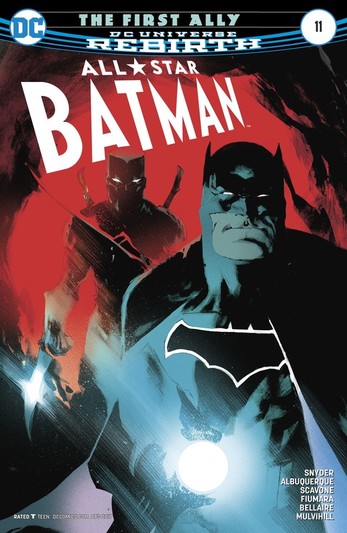 In issue 11 of All-Star Batman Scott Snyder takes us through an accelerated character history of Alfred Pennyworth that focuses on the impact of his absentee father. Unlike his adopted son, Alfred’s father was never around because of his dedication to serving the Wayne family an ocean apart from Alfred and his mother. In recounting his history, Alfred reveals that his origin, much like Bruce’s, began with anger and rebellion which was not curbed by the influence of a father figure. Leading off where the graffiti chase ended in the last issue, Snyder continues his characterization of young Alfred as a punk rock youth struggling to define himself in a fatherless home and ultimately coping with the death of his mother alone. This cruel negligence is lightened a bit by Rafael Albuquerque’s rendition of Alfred as a mohawked youth with multiple ear piercings. This punk origin gives us the vaguest sense of why Alfred has gone along with Bruce’s vigilante crusade for so long: it's a righteous inversion of the status quo and that is so punk rock. Batman operates outside the established order, with an admittedly rigid loyalty to American justice, but nonetheless the boldness of Batman’s stand against the corruption of the establishment speaks to a youthful rebellion that lives in Alfred still. After narrowly escaping an alligator-induced death thanks to a last-minute assist from the Black and Whites (Penguin, Black Mask, and Great White Shark) Batman discovers that the Genesis Engine he’s been tracking down is a device that can rewrite cellular biology, giving anyone with access to it the ability to create genetically designed monsters. Surprisingly, the Black and Whites are interested in the device because they want it destroyed and they saved Batman to help them. Batman's search for the Genesis Engine and Thatch’s mysterious murderer leads him to the massive Submarine Casino known as the Flying Dutchman operated by the Gangster, Tiger Shark. Finding himself once again a step behind, Batman arrives on the Dutchmen to discover the dual-bladed murderer of Thatch has killed the thugs onboard the submarine and already has the Genesis Engine. Batman himself is quickly dispatched as the villain, whose outfit closely resembles a medieval knight’s armor, slashes at both Batman and the glass interior of the sub, crippling both as Batman fights for consciousness and the sub begins to sink. The caped crusader’s peril is punctuated by flashbacks showing Alfred’s dissatisfaction with his decorated career in the SAS and his recruitment by a mysterious MI-5 operative named Briar. As the issue concludes it appears that Briar, who we discover to be the architect of the trap laid for Batman, threatened Alfred’s life in the past and it appears that both Pennyworth and Batman were unable to escape the violent machinations of this operative. One of the strengths of the All-Star Batman series has been how confidently and cleverly Snyder separates Batman from Gotham City, and this most recent arc has been no exception. Batman in Miami and Batman under the sea seem like very uncharacteristic combinations for the street-level vigilante however, the flair with which Snyder weaves in pirate lore into these settings suits the Bat really well. This fish-out-of-water setting (pun-intended) is reminiscent of the 90’s era of Batman action figures whose suits and gadgets corresponded to countless settings and scenarios. Snyder’s interpretation of Deep-Sea Batman is pure fun and manages to tell a compelling present and past story without getting too dark and gruesome. Artist Rafael Albuquerque returns and skillfully executes Batman and Alfred in both sunshine and shade amidst explosions and crocodiles. A particular favorite panel of mine depicts Alfred soaring over the open sea in a bat-shaped glider as Bruce is seconds away from an underwater oblivion. With only 3 issues remaining as All-Star Batman will be the first casualty among the Rebirth titles, Snyder’s 'First Ally' arc continues to fascinate and deliver the fun and dexterity of the caped crusader and one of his most talented chroniclers. Until next time, Geek On! Written by Joel T. Lewis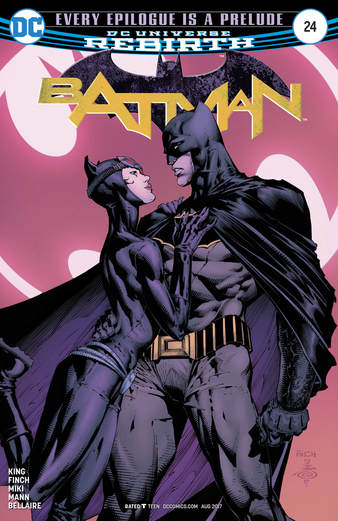 As Batman continues to examine his life and vigilante crusade after his father’s dying plea to find happiness, Tom King’s issue 24 focuses on an extended discussion between the caped crusader and Gotham Girl (Claire Clover). As Gotham Girl debates whether to remain a hero Bruce provides a new intimate perspective on his own fight against crime. Instead of just dictating what Claire ought to do, Bruce confides in her about how Alfred’s protests early on in his career as Batman had no effect on his plan to reshape the Gotham underworld. Batman’s measured compassion with Claire speaks to the impact that Thomas Wayne’s final words have had on the Dark Knight. The control and cold manipulation Batman has employed over the men and women he’s mentored has always created barriers, but this intimate honest discussion shows a dramatic shift in Batman’s mentoring philosophy. Batman is very candid about the nature of the mantle he created, 'I do this. But I’m not...happy...I do this to be happy. I try and I fail.' Claire responds in earnest, 'Why do you fail? Why can’t you be happy?' Batman replies, 'I fail because I’m scared. What I’ve seen. Gotham. Him. If you’re not scared...if all that doesn’t scare me...then I’m insane. And I’m not…I don’t want to be insane. So I’m scared.' Bruce’s vulnerability and self-awareness throughout this issue is poignant and powerful. Interlaced throughout this issue the brilliant David Finch depicts a late night game of Cat and Bat as Batman chases Catwoman over the rooftops of Gotham city. When Batman catches up to her one of the most important moments in Bat history takes place: Bruce Wayne proposes to Selina Kyle. Now this is not truly new territory as Bruce and Selina have been married way back in the Golden Age continuity but this has potential to be a development that sticks. In a sense, the bond between Batman and Catwoman is one fans have championed for nearly as long as Peter Parker’s been with Mary Jane or Clark Kent with Lois Lane, and rather than feeling hackneyed or cheap, Bruce’s proposal at the end of issue 24 feels completely earned. Though their relationship has run the gamut from intimate and tender to estranged and tumultuous, the playful connection between Catwoman and Batman has always felt weighted and genuine which is why this proposal doesn’t seem forced. Their dual lives, their unspoken respect for each other’s skills, and their complementarily damaged psyches have always led them back to each other and now they could be getting married. What does a married Bruce Wayne look like? How do a cat burglar and a superhero build a functional partnership? Where does Batman figure into this attempt at traditional domestic bliss? What does the wedding party look like? Though issue 24 doesn’t move mountains of plot, the questions it raises are fascinating and David Finch’s artwork is breathtaking. The stark contrast between Gotham Girl and Batman’s daylight discussion of heroes and their motivations and the late night scenes of Batman chasing the woman he loves are brought to brilliant life. These images weave their own narrative and were it not for Tom King’s brilliant deconstruction of Batman’s shifting motivations I would have said Finch’s work could have been published without words and the impact of that final page proposal would have been just as poignant. Though the next 8 issues of Batman are set a little over a year after Batman began his one-man war on crime I can’t help hoping that when we return to the present, Tom King treats us to a little more catharsis. I would love to see this vulnerable Bruce talk to Dick Grayson, confide in Alfred, maybe even Commissioner Gordon. It would be such a shame for this drastic re-examination of the purpose of Batman to only impact Gotham Girl and Bruce’s relationship when the most intimate and important members of the Bat-Family, those most affected by the ripples of Batman’s influence, could really grow and benefit from seeing Bruce transition. Tom King is doing a bang-up job with Batman and it is always a pleasure to see David Finch’s work and I cannot wait to see how the rest of the Selina Kyle/Bruce Wayne relationship unfolds and I’m really excited for King’s upcoming arc 'The War of Jokes and Riddles'. Until next time, Geek On! |
Archives
May 2024
|
|
© 2012-2025, Nerds That Geek LLC.
All Rights Reserved. |
uWeb Hosting by FatCow
